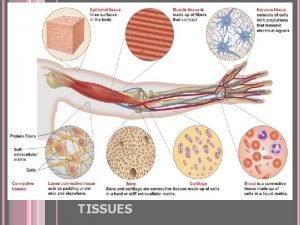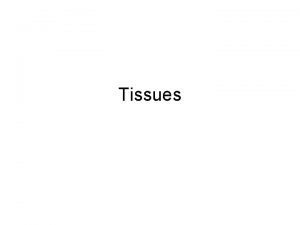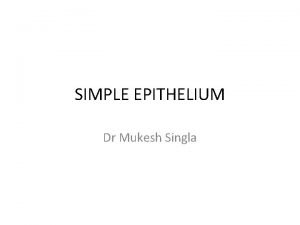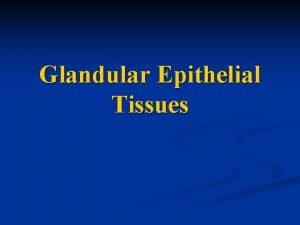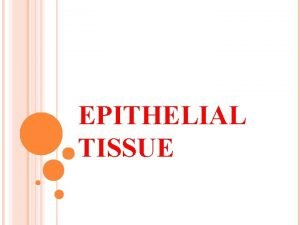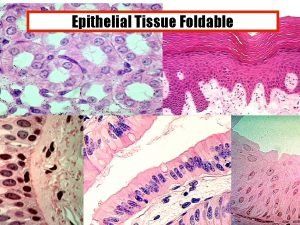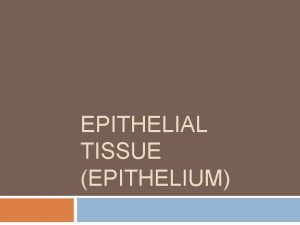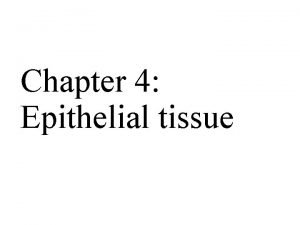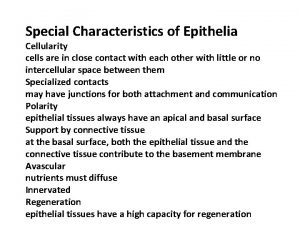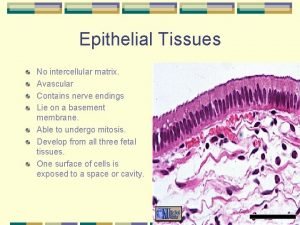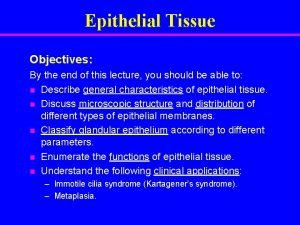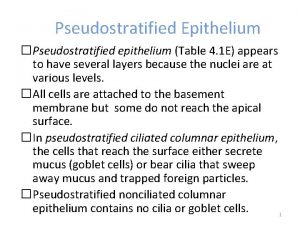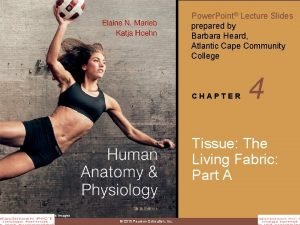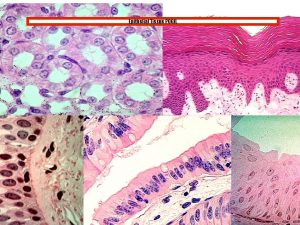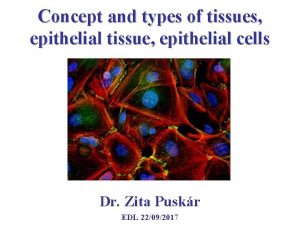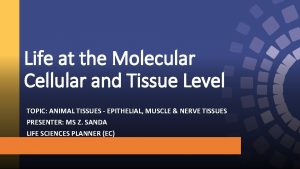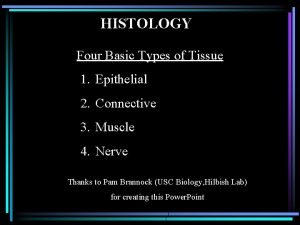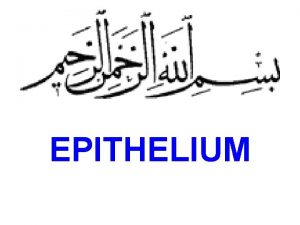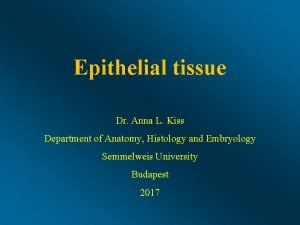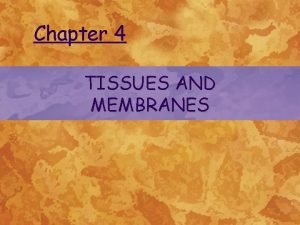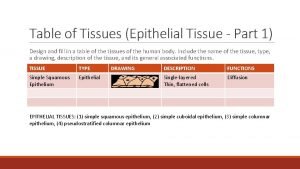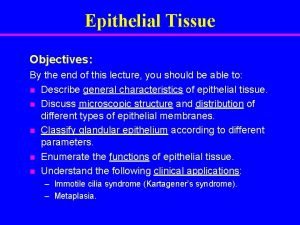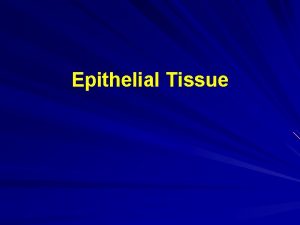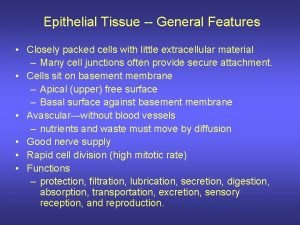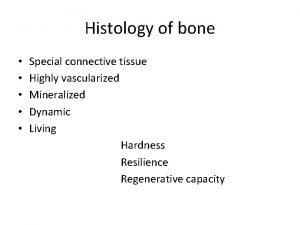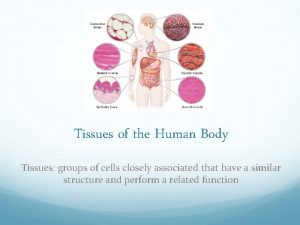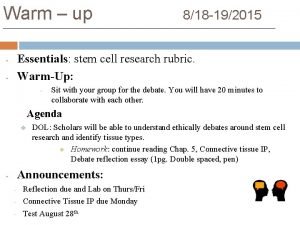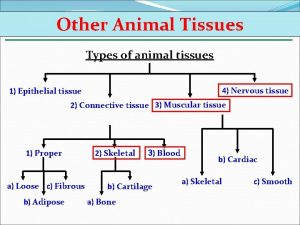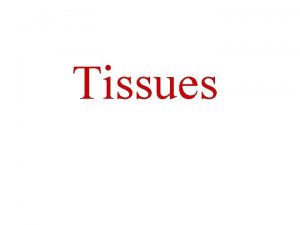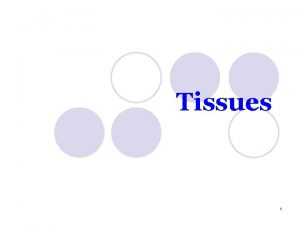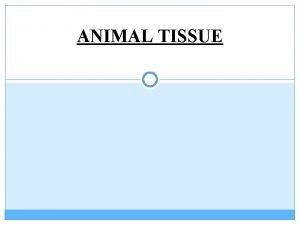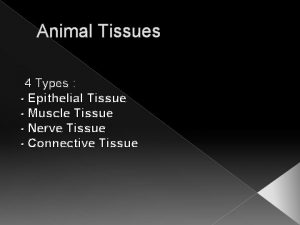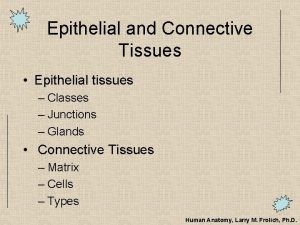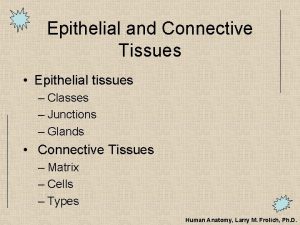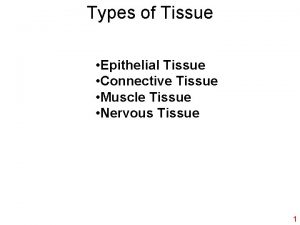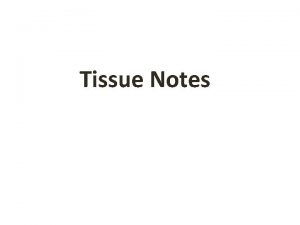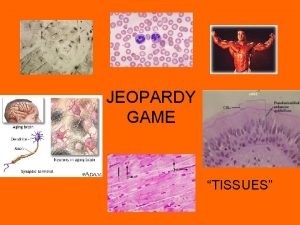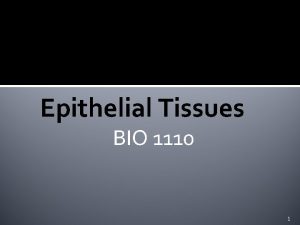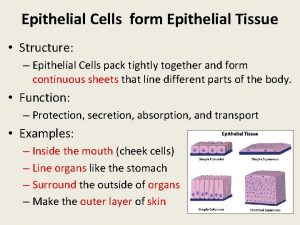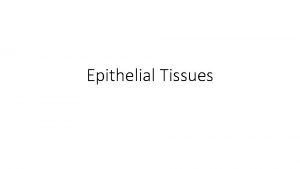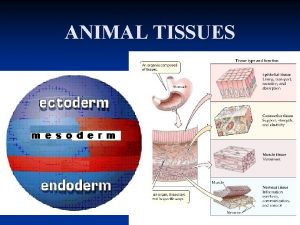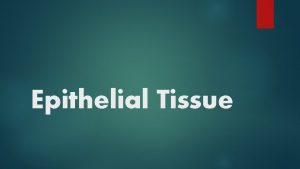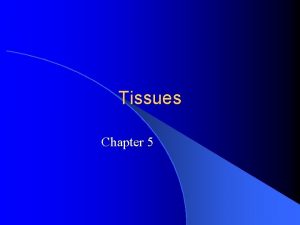Concept and types of tissues epithelial tissue epithelial




































- Slides: 36

Concept and types of tissues, epithelial tissue, epithelial cells Dr. Zita Puskár EDI. 22/09/2017

Levels of Body Organization


Where can we find epithelia? Surface (covering or lining) epithelia Sensory/Neuroepithelia Pigment epithelia Glandular epithelia

Epithelial Tissue Features of the epithelial cells: • Closely aggregated polygonal cells • Very little extracellular space • Strong adhesion among the cells Epithelial tissue is non-vascularized (no blood vessels) !!! Functions: • • • Covering, lining and protecting the surfaces Absorption, resorption (epithelia in the intestines) Secretion (glands) Contractility (myoepithelial cells) Specialized sensory function (taste bud, olfactory epithelium)

Basement membrane Function: structural and filtering function, influence cell polarity, regulate cell ploriferation and differentiation, influence cell metabolism and survival, pathway for migration

Classification by shape and number of layers Cell shape and number of layers • Number of layers - simple - stratified Simple epithelium: It is formed by a singe cell layer where each cell is attached to the basement membrane. Stratified epithelium: It is formed by more than one layer of cells but only cells in the basal layer are attached to the basement membrane. Pseudostratified epithelium: Each cell is attached to the basement membrane but the cell nuclei are at several different levels giving a stratified appearance of the tissue.

Morphological types of epithelial tissue Simlpe squamous cuboidal columnar Pseudostratified columnar Stratified (Classification is based on the cell shape of the superficial layer) keratinized squamous non-keratinized cuboidal columnar transitional epithelium (urothelium)

Quiz

Functional types of epithelial tissue Surface (Covering) Surface (Lining) Glandular Modified epithelial cells Myoepithel cells Sensory cells - Neuroepithelium taste buds in the tongue Pigment epithelium

Types of simple squamous epithelia epithel endothel kidney glomerulus blood vessel mesothel According to the location and function serous membrane

Simple cuboidal epithelia Exretory ducts of glands Kidney tubule

Simple columnar epithelia intestine

Pseudostratified columnar epithelia

Polarity of epithelial cells

Composition of the cytoskeleton Microtubules Cytoskeleton Filaments Microfilamens - actin filaments Intermediate filaments Accessory proteins Motor proteins

Specializations of the apical surface microvilli stereocilia (kino)cilia

Microvilli intestine

Parietal cells of the stomach

Stereocilia epididymis

(Kino)cilia

Specializations of the basal surface - basal striation Kidney

Cell adhesion Specific binding of a cell to other cells or to the extracellular matrix (ECM) is called cell adhesion, mediated by interactions between transmembrane glycoproteins called cell adhesion molecules (CAM) Function: development of tissues, cell migration, regulation of gene expression, cell proliferation and cell death, pathological processes (eg. cancer metastasis)

Adhesion proteins Common features: 1. Extracellular domain (interaction with other CAMs (homophilic binding) or ECM (heterophilic binding) 2. Trans membrane domain 3. Intracellular domain (interaction with the cytoskeleton)

Junctional complexes gj (a) Occluding junction, zonula occludens (tight junction) (b) adhesive junction, zonula adherens (c) macula adherens (desmosome) (d) hemidesmosome (e) gap junction

Junctional complexes in 3 D

General features of junctional complexes Transmembrane adhesion proteins: Connecting cell to cell → homophil binding (occludin, cadherin: Ca 2+ dependent adhering protein), Connecting cell to matrix → heterophil binding (integrins) Link proteins– connecting transmembrane adhesion proteins to cytoskeleton (spectrin) Components of the cytoskeleton (actin filaments, intermedier filaments) Types: Homophil-heterophil Ca 2+ dependent – Ca 2+ independent Strong - weak

Zonula occludens – tight junction Transmembrane proteins: occludin (Ca 2+ dependent) claudin, JAM (Junctional Adhesion Protein) Link (anchoring) proteins: Zo 1, Zo 2, Zo 3 Actin filaments Function: separation of the apical and basolateral surfaces, diffusion barrier in the membrane and intercellular space, prevention of the lateral diffusion of membrane components

Zonula adherens Function: • Firm mechanical junction • Encircles the cell • Ca 2+ sensitive • Insensitive to osmotic changes • Not a diffusion barrier Actin related (in heart muscle: band like - fascia adherens, in synapse: patch like - punctum adherens)

Macula adherens - desmosome plaque • Related to intermedier filaments (keratin filaments) → form networks • Patch like (patent) • Firm connection (skin, heart muscle) Desmosomal cadherins : desmoglein and desmocollin - together desmoglea Cytoplasmatic plaque: desmoplakin, plaktoglobin

Desmosomal connections

A disease of desmosomes: pemphigus Blistering autoimmune disease in which antibodies form against desmoglein (the transmembrane desmosomal cadherin) and the cells of stratum spinosum are separated from each other (unglued). (Blisters→sores)

Hemidesmosome - Half desmosome This is not a desmosome! Binds the epithelium to the basement membrane Transmembrane proteins – integrins bind to intermedier filaments of the cell and to laminin molecule of basal lamina

Gap junction Channel pore: 1. 5 nm • Structural unit: connexon that consists of 6 subunits. The major protein of the subunits: connexin • Small molecules, ions move through the pores • Special signal transduction (c. AMP, c. GMP) • Opening and closing of the channel is Ca 2+ and p. H dependent • Appears also in heart muscle, electric synapse gap: 2 -4 nm

Transport across epithelia Sodium pumps (Mg 2+ activated Na+/K+ ATP-ase) Transcellular transport (fluids and ions) Transcytosis (pinocytotic vesicles)

References: Röhlich Pál: Szövettan, Budapest, 2006 Anthony L. Mescher: Junqueira’s Basic Histology, New York, 2010 Michael Ross and Lynn J. Romrell: Histology, Baltimore, 1989 Geoffrey M. Cooper and Robert E. Hausman: The Cell, A molecular Approach, (ASM, Sinauer), Washington, Sunderland, 2009 Darvas Zsuzsa és László Valéria: Sejtbiológia, Budapest 2005
 Body tissues chapter 3 cells and tissues
Body tissues chapter 3 cells and tissues The 4 tissues
The 4 tissues Body tissues chapter 3 cells and tissues
Body tissues chapter 3 cells and tissues Stained cheek cell
Stained cheek cell Eisonophil
Eisonophil Types of tissue
Types of tissue Layers of epithelial tissue
Layers of epithelial tissue Layers of epithelial tissue
Layers of epithelial tissue Glandular epithelial tissue
Glandular epithelial tissue Stratified squamous non-keratinized epithelium
Stratified squamous non-keratinized epithelium Epithelial tissue
Epithelial tissue Kidney epithelial tissue
Kidney epithelial tissue Layers of epithelial tissue
Layers of epithelial tissue Cell shape
Cell shape Cellularity of epithelial tissue
Cellularity of epithelial tissue Avascular epithelium
Avascular epithelium Epithelial tissue
Epithelial tissue Type of tissue
Type of tissue Stratified columnar epithelium
Stratified columnar epithelium Epithelial tissue with goblet cells
Epithelial tissue with goblet cells Epithelial tissue pogil
Epithelial tissue pogil Epithelial tissue
Epithelial tissue Voluntary muscles
Voluntary muscles Epithelial tissue
Epithelial tissue Part of an animal
Part of an animal Pseudostratified columnar epithelium
Pseudostratified columnar epithelium Epithelial tissue
Epithelial tissue Epithelial tissue
Epithelial tissue Protein fibers in connective tissue
Protein fibers in connective tissue Tissue design for table
Tissue design for table Epithelial tissue
Epithelial tissue Histology
Histology Filtration epithelial tissue
Filtration epithelial tissue Is epithelial tissue highly vascularized
Is epithelial tissue highly vascularized Tissue types in the body
Tissue types in the body Types of tissues
Types of tissues Types of tissues
Types of tissues





